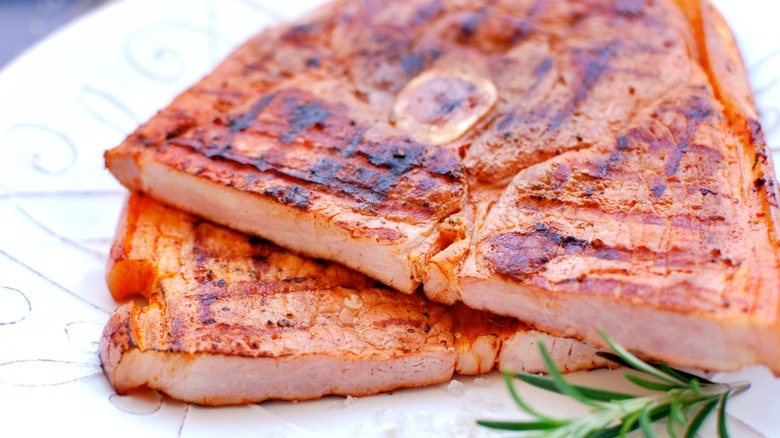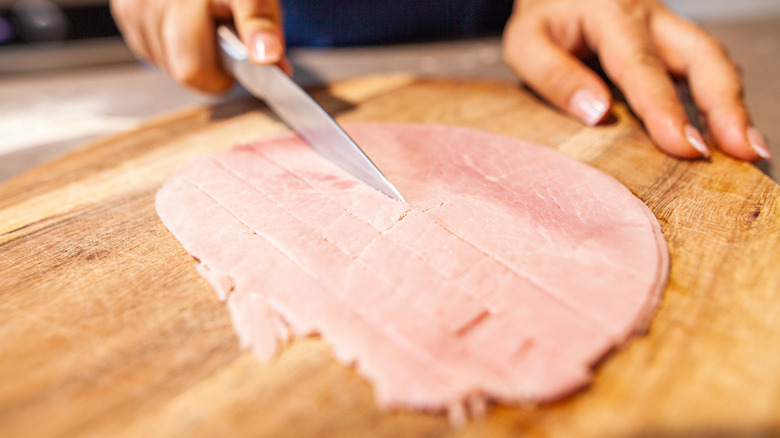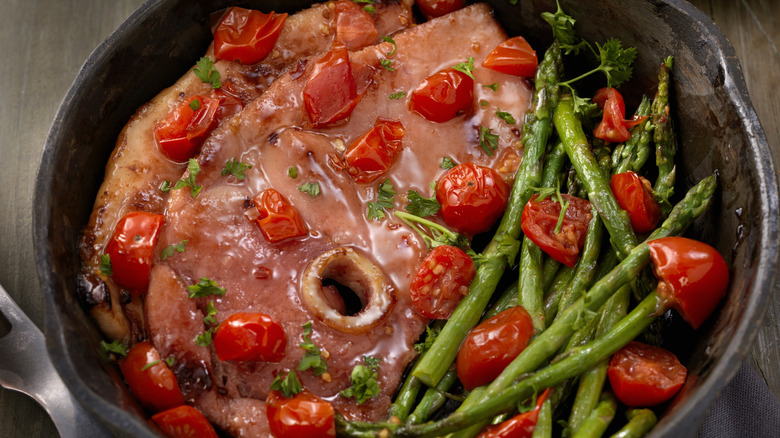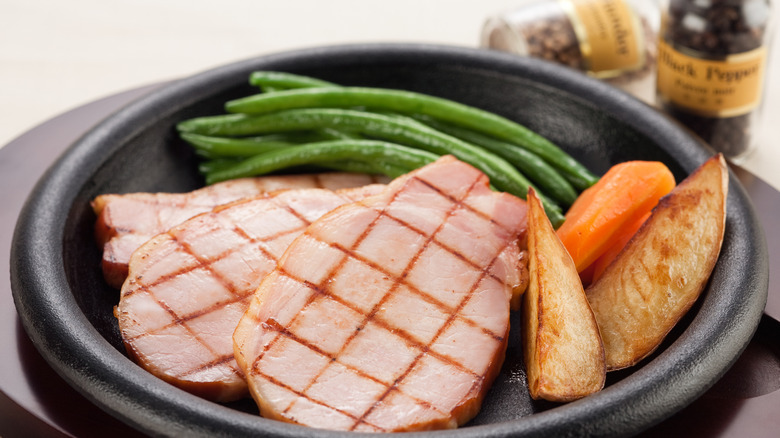Why You Should Stop Overlooking Ham Steaks
If you hear the word "steak," beef likely comes to mind. But while it's the strongest association — and the root of the dictionary definition — the term has expanded to embrace everything from tuna to cauliflower. As long as it's thick and seared, it fits the bill, and that includes ham steak, too. Outside of a tasty sandwich filling, thick cuts of the cured meat are delicious sizzled.
Ham steak is malleable, its thick consistency shining on a skillet, in the oven, or even on a grill. Most ham steaks are pre-cooked, too, since they're often brined and smoked before they hit the shelves. For this reason, it's a useful protein option to have on hand — there's less stress over raw spoilage and it's easier to purchase in bulk.
Ham steak was more frequently advertised in the mid-20th century, accompanied with nostalgic sides and even sold in namesake tins. Although the food's lost fashion since, it's a protein that's undoubtedly worth a second look. Simply buy a slice of this thick and tasty pork product and cook it up to perfection. It'll shine with a convenient and heart-warming character that you won't forget.
Ham steaks are versatile cuts of pork
Ham steak refers to several cured cuts prepared in a similar manner. Most often, the cut is a type of city ham, which means that it's wet-brined and smoked prior to sale. This variety is fully cooked, lending it a quality similar to other popular deli meats. However, raw ham steak varieties also exist, so make sure to double check the label prior to purchase.
The cut is often sold bone-in or with a hole, as it's butchered from the leg or shank. It's sliced into a large, thick cross section, anywhere from a ½ inch to 2 inches in width, with a weight around 2 pounds. Such a steak-like quality separates it from other hams — its hefty nature makes it ready for a full-scale dinner without overwhelming in flavor.
Additionally, ham steaks are a type of center cut, which means they have a smooth texture and a very bright, reddish color that's typical for this kind of pork. With a composition on the leaner side, they exhibit a few slivers of fat but no fat marbling. Their meatier nature means there's no need to worry about excessive fat melting during preparation — the meat delectably scorches up under high heat. Neither too chewy nor greasy, it's a balanced type of cured pork that'll meld with easygoing sides like potatoes, asparagus, or a nice salad.
They can be prepared with different methods
A pan-sear is the most natural cooking method for ham steak. Do as you would with other steaks and heat a skillet with oil. Perhaps season using spices like cayenne, garlic powder, and dried herbs. For added caramelization, add some brown sugar at the end to create a delicious crust. Just remember to go light on the salt, since the cut's brined, and be mindful not to burn the meat.
If you're after a more smoky flavor, the grill can create delicious ham steaks, too. Warm to medium heat, then place the large pork steak atop the grates, once again lightly oiled. Make sure to heat the ham steak all the way through — around five minutes per side or until they're cooked to 140 degrees Fahrenheit is ideal. Rather than spices, use a glaze to amply the flavor. Try a grilled take on the classic honey mustard-glazed ham, use an orange marmalade for fruitier notes, or add some boozy brown sugar bourbon to shine alongside the pork.
And finally, another ham steak preparation worth considering is the oven. If you're after a more seared, crispy consistency, then broiling is a delicious cooking method for the task. Add the ham steak to a pan with a glaze and leave it on moderate heat for just a few minutes. Or if you're after a more warmed, low and slow rendition, simply cook the meat in the oven for half an hour.
Ham steaks trace back over a century
Ham has been around for centuries — the Chinese are credited for curing the first legs as far as 4900 B.C. Centuries later, the preparation style spread to Rome, where it was embedded into a variety of European cuisines. Christopher Columbus carried pork over on his first journeys to North America, and as part of the Columbian exchange, curing took off among both New World settlers and in Native American communities. As a result, many methods of ham production arose worldwide.
The ham steak style came along with the invention of wet brining, which is strongly intertwined with English hams from Wiltshire. It's considered that the technique emerged in the 1840s, submerging large leg hams in a wet salt solution, thereby creating a meatier, less bold cured meat. Although precise origins are unknown, it's reasonable to assume the ham steak cut took off soon after.
In the U.S., ham steaks became more prominent during the 1950s, a time when processed foods were trending. Served with accompaniments like potatoes and peas, they were simple meals that could be whipped up right out of the fridge. In fact, ham steaks were affiliated with their own brand of nostalgic memorabilia, sometimes sold in specialized tins. Although not as quirky as other 1950s foods, ham steak nonetheless deserves a second glance.



